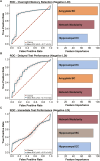Individual differences in medial temporal lobe functional network architecture predict the capacity for sleep-related consolidation of emotional memories in older adults
- PMID: 40442306
- PMCID: PMC12417020
- DOI: 10.1093/sleep/zsaf117
Individual differences in medial temporal lobe functional network architecture predict the capacity for sleep-related consolidation of emotional memories in older adults
Abstract
Study objectives: Memory consolidation during non-rapid eye movement slow wave sleep (NREM SWS) involves reactivation of a hippocampal index which integrates distributed cortical representations of an experience. This study examined whether individual differences in brain network properties that align with this theoretical organization were associated with interindividual variability in memory consolidation during sleep.
Methods: Thirty-six older adults (μage = 72.9 ± 5.6) completed overnight polysomnography with pre- and post-sleep emotional memory testing. Slow oscillation (SO) power and SO-sleep spindle (SO-SP) coupling were computed. Participants also completed 3T structural and resting-state functional magnetic resonance imaging (rsfMRI). Resting-state fMRI network modularity (Q), hippocampal and amygdala eigenvector centrality (EC), and betweenness centrality (BC) were calculated.
Results: Greater Q was associated with reduced emotional memory retention and greater SWS. Hippocampal and amygdala EC were associated with better emotional memory retention. Hippocampal BC was associated with immediate test performance, whereas amygdala BC was associated with delayed test and memory retention. Hippocampal centrality measures were associated with SO power and SO-SP coupling. Random forest classification revealed distinct network measure combinations predict different stages of memory processing.
Conclusions: Network integration supports overnight emotional memory retention. Individuals with more influential medial temporal lobe nodes exhibited better memory consolidation, suggesting functional network architecture contributes to memory processing. These measures were associated with sleep oscillations implicated in consolidation. Individual differences in functional network organization may predict the capacity of older adults to consolidate memories.
Keywords: consolidation; graph theory; memory; networks; resting-state; sleep.
© The Author(s) 2025. Published by Oxford University Press on behalf of Sleep Research Society.
Figures






Update of
-
Medial temporal lobe functional network architecture supports sleep-related emotional memory processing in older adults.bioRxiv [Preprint]. 2023 Nov 1:2023.10.27.564260. doi: 10.1101/2023.10.27.564260. bioRxiv. 2023. Update in: Sleep. 2025 Sep 9;48(9):zsaf117. doi: 10.1093/sleep/zsaf117. PMID: 37961192 Free PMC article. Updated. Preprint.
References
-
- Cahill L, McGaugh JL. Modulation of memory storage. Curr Opin Neurobiol. 1996;6(2):237–242. doi: https://doi.org/ 10.1016/s0959-4388(96)80078-x - DOI - PubMed
-
- Eichenbaum H. Hippocampus: cognitive processes and neural representations that underlie declarative memory. Neuron. 2004;44(1):109–120. doi: https://doi.org/ 10.1016/j.neuron.2004.08.028 - DOI - PubMed
-
- McClelland JL, McNaughton BL, O’Reilly RC. Why there are complementary learning systems in the hippocampus and neocortex: insights from the successes and failures of connectionist models of learning and memory. Psychol Rev. 1995;102(3):419–457. doi: https://doi.org/ 10.1037/0033-295X.102.3.419 - DOI - PubMed
-
- Penfield W, Milner B. Memory deficit produced by bilateral lesions in the hippocampal zone. AMA Arch Neurol Psychiatry. 1958;79(5):475–497. doi: https://doi.org/ 10.1001/archneurpsyc.1958.02340050003001 - DOI - PubMed
-
- Scoville WB, Milner B. Loss of recent memory after bilateral hippocampal lesions. J Neurol Neurosurg Psychiatry. 1957;20(11):11–21. doi: https://doi.org/ 10.1136/jnnp.20.1.11 - DOI - PMC - PubMed
MeSH terms
Grants and funding
LinkOut - more resources
Full Text Sources

